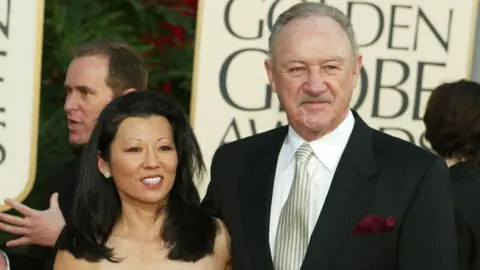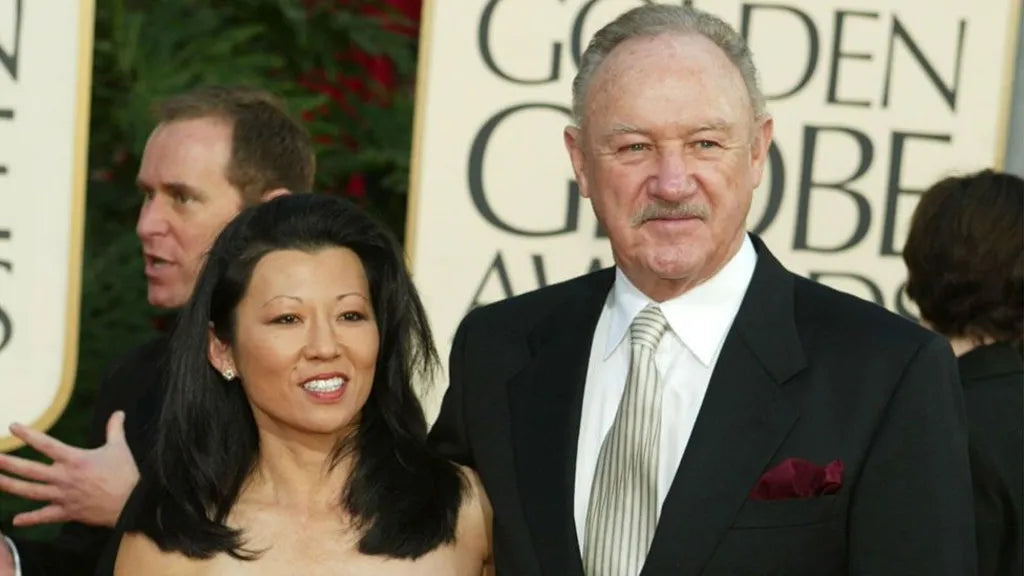Legendary Hollywood actor Gene Hackman and his wife, Betsy Arakawa, were found dead in their Santa Fe, New Mexico, home Wednesday, prompting investigating officials to call their deaths "suspicious."
The bodies of Hackman, 95, and Arakawa, 65, were found in separate rooms, according to the Santa Fe County Sheriff's Office. One of their dogs was also found dead.
Hackman was an Oscar-winning actor who was best known for roles in "The French Connection," "The Conversation" and "Unforgiven." Arakawa was a classical pianist.
Here is what we know about their deaths.
Gene Hackman, an iconic actor, is renowned for his roles in films like The French Connection, Unforgiven, and Hoosiers. However, Hackman is also known for a diverse career that spans various genres in Hollywood, but there's no well-known record of him performing in plays at "Holliday Lake." It seems like there may be some confusion or mix-up regarding that specific location or stage.
Hackman did, however, have a rich stage career before making a significant mark in movies, performing in various theater productions. He attended the University of Illinois, where he was active in theater, and continued honing his craft. Early on, Hackman worked in the theater before making his transition to film, so while he may not have performed at Holliday Lake, his theatrical roots were foundational to his later success in Hollywood.
As for Hackman's death, it's important to note that as of now, Gene Hackman is still alive. He was born on January 30, 1930, and while he has retired from acting, he remains one of the most respected figures in Hollywood.

Hackman gained further fame for his portrayal of Lex Luthor in Superman (1978) and its sequels Superman II (1980) and Superman IV: The Quest for Peace (1987). He also acted in: The Poseidon Adventure (1972), Scarecrow (1973), The Conversation (1974), A Bridge Too Far (1977), Under Fire (1983), Power (1986), Loose Cannons (1990), The Firm (1993), The Quick and the Dead (1995), The Birdcage (1996), Enemy of the State (1998), Behind Enemy Lines (2001), The Royal Tenenbaums (2001) and Runaway Jury (2003). He retired from acting after starring in Welcome to Mooseport (2004).
1. The Early Life of Gene Hackman: From Humble Beginnings to Hollywood
Gene Hackman was born in San Bernardino, California, in 1930, to a troubled family. His parents’ divorce when he was young left Hackman to navigate a difficult childhood, eventually enlisting in the U.S. Marine Corps after high school.
Upon leaving the military, he attended the University of Illinois to study journalism before deciding to pursue acting, which led him to the Pasadena Playhouse and eventually to New York City.
In New York, Hackman trained under the tutelage of iconic acting teachers like Stella Adler and Lee Strasberg. His early life and struggles in New York’s theater scene helped shape his gritty, no-nonsense acting style that would later resonate in Hollywood.
2. Hackman’s Breakthrough Role: The French Connection and Its Impact on His Career
Hackman’s breakout moment came with his role as Detective “Popeye” Doyle in The French Connection (1971), a gritty crime thriller directed by William Friedkin.
His portrayal of the tough, obsessive cop earned him critical acclaim and an Academy Award for Best Actor. The film itself, based on a real-life drug case in New York, became one of the most influential thrillers of its time.
Hackman’s intense performance as Doyle was the catalyst for his Hollywood stardom, establishing him as a leading man capable of portraying complex and often morally ambiguous characters.
3. Gene Hackman’s Most Iconic Villain Roles: A Look at His Powerful Antagonists
Gene Hackman wasn’t just the hero; he excelled at playing compelling villains, offering some of his most memorable performances in antagonist roles.
Perhaps most famous for playing the ruthless Lex Luthor in the Superman films (1978, 1980), Hackman brought a layer of charm and menace to the character, making him a standout in the superhero genre.
Other notable villainous performances include his portrayal of the brutal Sheriff Little Bill Daggett in Unforgiven (1992), which earned him another Academy Award. Hackman’s knack for playing complex antagonists helped solidify his place as one of Hollywood’s greatest actors, capable of both heroism and villainy with equal skill.
4. The Evolution of Gene Hackman: How His Acting Style Changed Over the Years
Hackman’s acting evolved significantly over the decades. In his early years, he was known for playing gritty, working-class characters and antiheroes, often with a sense of realism that resonated with audiences.
As he matured, his roles became more diverse, with Hackman taking on everything from military men to political figures. His transformation from the raw energy of The French Connection to the more nuanced, reflective performances in films like The Royal Tenenbaums (2001) showed his ability to adapt and grow as an actor.
This evolution also saw him become a highly respected character actor in his later years, with roles that showcased his wisdom and depth.
5. Hackman’s Diverse Roles: From Action Films to Dramatic Performances
One of the most remarkable aspects of Gene Hackman’s career is his incredible range across genres. While he is perhaps best known for his action roles, such as The French Connection and Enemy of the State (1998), Hackman also proved himself as a talented dramatic actor.
He starred in powerful dramas like The Conversation (1974), a film directed by Francis Ford Coppola, in which Hackman played a reclusive surveillance expert who becomes paranoid about his work.
He also showed his comedic chops in The Birdcage (1996), playing the uptight father of Robin Williams’ character. Hackman’s versatility allowed him to navigate both high-octane action films and intimate, character-driven dramas with ease.
6. Gene Hackman and the Oscars: His Awards and Nominations
Gene Hackman’s accolades include two Academy Awards for Best Actor and Best Supporting Actor, making him one of the most decorated actors in Hollywood history. His first Oscar came for The French Connection, and his second was for his role in Unforgiven (1992), where he played the sadistic sheriff.
In addition to these wins, Hackman received numerous nominations throughout his career for films like The Royal Tenenbaums, Mississippi Burning (1988), and The Conversation. His consistent recognition by the Academy cemented his reputation as one of the finest actors of his generation.
7. Hackman’s Most Memorable On-Screen Partnerships
Gene Hackman’s career has been defined by memorable on-screen partnerships with some of the biggest stars in Hollywood. Whether it’s his iconic pairing with Roy Scheider in The French Connection, or his work with Clint Eastwood in Unforgiven, Hackman has always excelled when working with strong co-stars.
His chemistry with Dustin Hoffman in All the President’s Men (1976) and with Meg Ryan in The Money Pit (1986) showcased his ability to connect with other actors, making their collaborations some of the most powerful in Hollywood. These partnerships helped elevate Hackman’s performances and contributed to the success of the films themselves.
8. Gene Hackman’s Influence on Modern Hollywood: How He Paved the Way for Future Actors
Gene Hackman’s impact on modern Hollywood is profound. His approach to acting—often characterized by a gritty realism, subtlety, and a willingness to dive into morally gray areas—has influenced countless actors who came after him.
Hackman showed that you didn’t need to be a traditional leading man with polished good looks to become a star. Instead, his dedication to authenticity and complexity opened doors for more nuanced performances in action and drama films. Modern actors like Edward Norton, Joaquin Phoenix, and Matt Damon have all cited Hackman as an influence, pointing to his skill at blending intense emotion with subtlety.
9. Behind the Scenes: Gene Hackman’s Life Off the Screen
Gene Hackman was known for his private life and preference for staying out of the Hollywood spotlight. After retiring from acting in the early 2000s, Hackman focused on his personal interests, including writing.
He authored several novels, proving his creativity extended beyond the silver screen. Hackman also distanced himself from the Hollywood scene, preferring to live a quieter life.
His decision to step away from acting came after a successful career in both film and television, leaving a lasting impact on those who admired his work. His life off-screen remains relatively low-key, in keeping with his humble and unassuming persona.

10. The Enduring Legacy of Gene Hackman: Why He Remains a Hollywood Icon
Gene Hackman’s legacy endures because of his impeccable body of work. Even though he has retired from acting, his films continue to be celebrated, and his characters remain iconic.
Hackman’s roles in films like The French Connection, Unforgiven, Hoosiers (1986), and The Conversation are studied by aspiring actors and celebrated by fans. Hackman’s ability to transform into a wide range of characters—from heroic figures to villainous antagonists—has made him an enduring figure in cinematic history.
His performances still influence modern filmmakers and actors, ensuring that his legacy as a Hollywood icon remains intact for generations to come.























Share:
Juice Lovers, Meet Your New Favorite: The Magic of Stem Juice
The Best Juicer Machines of 2025: Which One Should You Buy?